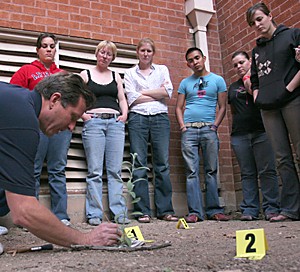A handful of UA students used screens, sifters and other forensic tools to uncover evidence from a mock crime scene for an anthropology class yesterday.
The 16 students in Introduction to Forensic Anthropology who participated in the event were required to behave as if they were professional forensic anthropologists at a real crime scene.
The University of Arizona Police Department helped set up the “”scene,”” complete with caution tape, cones and evidence numbers on the northwest side of the Emil W. Haury Anthropology Building, 1009 E. South Campus Drive.
Students analyzed the mock remains of an item buried in the softened dirt by a tree in the corner of the building. Clues included a discolored patch of dirt with a growing plant, which was presumed to be the result of a buried specimen.
“”The conclusion of the scene was that the evidence was nonhuman,”” said Zanni Davis, an anthropology senior. “”We found a (bear’s) hand, the animal’s arm radius and ulna (bones).””
Derrick Pooyouma, an anthropology junior, said he agreed with Davis’ conclusion that the evidence was nonhuman.
“”One of the major differences we noticed was that the (bones) did not resemble a human bone,”” he said.
Participating in the mock crime scene helped students further their career choices in the various anthropological fields, Pooyouma said.
“”I learned that there are very many different aspects in the process of investigating,”” Pooyouma said. “”The way you go about things, working with the police department and all the rules that are set – what you can do and what you can’t.””
Pooyouma said the mock crime scene gave him an overall idea of how things work.
“”When you go into a scene, you learn what to look for, what to write down and how to record the evidence,”” he said.
Anthropology professor Bruce Anderson said the hands-on lab provided students with a realistic approach to a crime scene and how forensic anthropologists work.
“”How to determine bone from nonbone, how to conduct yourself at the medical examiner’s office and at a crime scene are all things we are trying to teach students,”” Anderson said. “”Everything is all pretty realistic.””
Officers Frank Romero and Andrew Valenzuela of the UAPD’s crime prevention unit were both present at the “”scene”” and directed students as if they were actual forensics workers.
“”We love working with students,”” Romero said. “”Any interaction that we can get with students is very important to show students how we work and what we do.””
The importance of the mock scene was to show students crime-scene control and other various aspects, Valenzuela said.
“”When we have an opportunity to come out and develop a mock crime scene,”” Romero said, “”it really gives the students an opportunity to interact with actual police, journalists and their partners.””
While exhuming and cataloging evidence, many students treated the assignment like they would a serious crime scene.
When questioned while conducting forensics on the scene, most students stayed in character and directed the media to the UAPD like a forensic scientist would.
“”For me, the biggest benefit was to see how the recovery of forensic evidence of a recent crime is different from archeological excavations,”” said Damien Huffer, an anthropology graduate student. “”I especially liked the little quark at the end when we found out it was a bear paw.””









